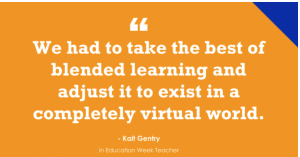Blended Learning in the Age of Covid-19

While blended learning has been a leading trend in education the past few years, the transition to distance and/or hybrid learning due to school closures has made educators and school leaders reimagine blended learning for these learning environments. One publication that presented a number of insights on the topic is the popular Education Week blog Classroom Q&A, which asked teachers to share their best strategies for blended learning during COVID-19. One of those teachers was Kait Gentry, a middle school learning and support coordinator in Baltimore who uses InferCabulary in her classroom.
Kait described how she worked with teachers in her school to take the best of blended learning and adjust it to exist in a completely virtual world. She wrote, in part, “As we transitioned to remote learning, we worked to capture the benefits of ‘traditional’ in-person learning through live, virtual small-group classes, which allowed students to ask clarifying questions in real time and to provide peer-to-peer learning opportunities, as well as critical social interactions.” She also described how she incorporated online learning tools into the school’s virtual blended learning model to help further engage students, “Blended learning also incorporates online learning tools, whether it is in class or at home, that can offer more personalized learning experiences for students. For example, vocabulary development can vary drastically among individual students. Using an online tool like InferCabulary allows my students to work through developing new vocabulary words at their own pace and level. Over time, the program learns what words a student has mastered and which words still need additional work, providing a more customized learning experience than traditional pen and paper vocabulary assignments.”
Read more in the Education Week article, “Blended Learning in the Age of COVID-19”

